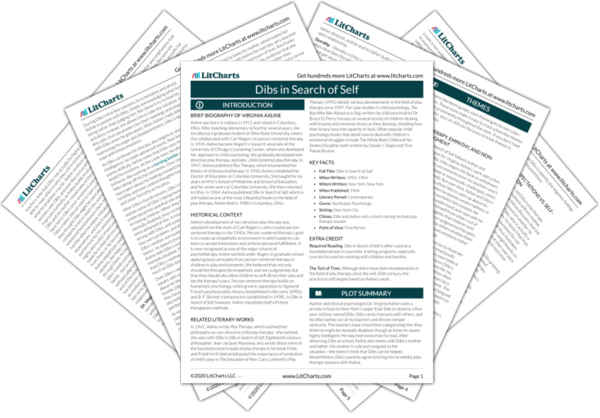Summary
Analysis
Dibs arrives happily for his 11th session. He notices a fence that another child built in the sandbox, and he quickly removes it. He also takes a gun from the sandbox and puts it in a drawer. When Dibs opens the window, he talks to the air, telling it to come inside. He then tells Axline that his father doesn’t like it when he talks to the air instead of to his father; often Dibs doesn’t answer his father, which makes his father angry. Axline notes that Dibs withholds speech as a way to get back at his father. Dibs then takes out the gun and points it at the father doll, saying that if he speaks, Dibs will shoot him. After this threat, Dibs hides the gun in the basement of the dollhouse so that nobody gets hurt.
Dibs’s arrival at this session shows a great deal of progress. Unlike Dibs’s disappointment at the duck and the mountain being moved in Chapter 7, here Dibs is much more secure. If he doesn’t like something about his surroundings, he knows he has the power to change it. However, Dibs’s story about his father hints at burdens he still carries. Dibs intentionally uses his father’s expectations—like the fact that his father thinks Dibs should speak to him—against him. But Dibs diminishes his own capabilities in the process. This leads to a harmful cycle of emotional disconnection from and anger toward his father.
Themes
Dibs then says that there are children in his room at school who are very interesting. Axline asks if Dibs wants another child to come and play with him in the playroom, but Dibs grows very angry, saying “Don’t want anybody else in here!” He says that no one likes him and they wouldn’t come. Axline asks if another child wanted to come, whether he would let them. Dibs says no, shouting that the room is just for him and Axline; he is close to tears. Axline says she understands and confirms the room can be just for the two of them if he wants it that way.
Dibs’s reaction here speaks to the trust that he and Axline have built together, but it also shows that Dibs still mistrusts everyone who isn’t her. This indicates that while he’s learning confidence in therapy, he still isn’t fully able to carry confidence and security through to the outside world. He is still hesitant about change, particularly when it comes to trusting other children, and his infantile language reflects his inability to fully cope with change or unpredictability.
Themes
After a few moments, Dibs says tentatively that he likes the other children, but he doesn’t want them in the room with him. Then he goes over to the sink and adjusts the faucet. He says, “I can stop it. I can go it,” and, “I am Dibs. I can do things. I like Dibs.” Dibs then starts filling water bottles and pouring them into each other. He is excited at his ability to manipulate the water.
Dibs’s emotional distress at the prospect of having another child in the room leads him to revert to more juvenile language and behavior, reinforcing the continued conflict between his intelligence and his emotions. At the same time, Dibs is finding joy in autonomy is growing more confident in his abilities.
Themes
Dibs starts to talk to the water bottle, but then he chides himself and instructs himself to talk to people instead. He says that if he wants to say hello to the bottle, he can in this room. Dibs asks Axline to put the top on his nursing bottle, and then Dibs drinks from it. Dibs says if he wants to be a baby, he can be, and if he wants to be a grown-up, he can be that, too.
Dibs continues to find freedom in determining his own activities. Instead of living up to his father’s expectations of talking to people rather than objects and being a grown-up rather than a baby, Dibs is comforted by an environment in which he can do whatever he wants without judgment.
Themes
Get the entire Dibs in Search of Self LitChart as a printable PDF.

Dibs goes over to the easel and mixes up the paints and the brushes, then he puts the brushes back in their proper jars, saying there is a correct way to do everything. But, he says, in the room, he can mix them up, too. He concludes, “In here, it’s all right just to be.” He says that Axline understands what he means, and he pats her hand and smiles at her.
Dibs’s tender declaration here emphasizes the freedom he feels in doing what he wants. While his parents have a “correct way to do everything,” in the play therapy room Dibs doesn’t have to fear his own childishness or mistakes.
Themes
Dibs then asks to go to Axline’s office. Once there, he looks at her books and her dictionary before saying that soon it will be time for him to go. Then, he repeats that he doesn’t want anyone else in the playroom “yet.” Axline wonders if this means a seed had been sowed in his mind to bring a friend someday, or to make a friend at school. When the session ends and Dibs goes into the reception room, he flings his arms around his mother and cries out that he loves her. Dibs’s mother starts to cry as she leaves with Dibs.
Dibs’s subconscious openness to making a friend (as suggested by the word “yet”) coupled with his reaction to his mother marks a huge change for Dibs. Even though he is still expressing some hostility towards others (and particularly his parents) in therapy, being able to express those emotions enables him to move past them and express his deep love for them as well.
Themes












